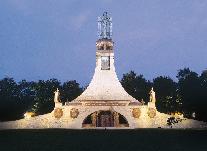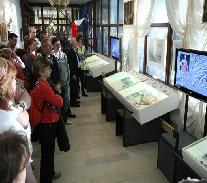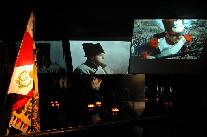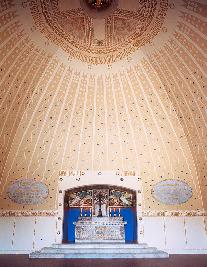EUROPE
The Cairn of Peace Memorial (Czech Republic)
(April 16, 2009)
by Jaromir Hanak, Vice Director
The Cairn of Peace Memorial was built at the beginning of the 20th Century to honour the victims of Napoleon's victorious battle at Austerlitz. This battle, in the middle of Moravia in the Czech Republic, was the decisive battle of the campaign of 1805. The French "Grand Armee" defeated the outnumbered Austro-Russian Allies led by the Austrian and Russian Emperors. After that battle, known by the name "The Battle of the Three Emperors," new geopolitical conditions in Europe were established with the French Empire ruling over Europe.
In line with the vision of A. Slovak, a priest, the centre of the former battlefield was made into a pious place of reconciliation--a memorial of the war. The Cairn of Peace Memorial stands here in the protected historical monument area of the Battle of Austerlitz where more than 15,000 soldiers lost their lives in just a few hours. Many more, including local people affected by the fighting, died within the following days.
Each year at the beginning of December, a ceremony to honour the fallen soldiers, the climax of commemorative events marking the anniversary of the battle, takes place in the area surrounding the monument. Besides the chapel of the memorial where the remains of the dead have been buried, visitors can view the new multimedia exhibition titled "The Battle of the Three Emperors: Slavkov / Austerlitz 1805" which is housed in a renovated museum adjoining the monument. Open since 2005, the 200th anniversary of the battle, the exhibition provides a modern presentation, including a choice of commentary in five spoken languages.
The concept behind the exhibition is that the military campaign of 1805, which culminated in the Battle of Austerlitz, is a historical event as well as a live phenomenon of history, on two levels: documenting the facts of the battle while re-living the battle from an emotional point-of-view. The makers of the exhibit have tried to bring visitors closer--next to a monument built in honour of the victims of a bloody battle--not only to the military and political fame of the period but also to its darker side. In other words, not only to the "glory" of a soldier's life but also its misery.
The first part of the exhibition, "Before the Battle," covers the period from the French Revolution until the eve of the Battle of Austerlitz. The second part, "The Battle," provides visitors with the emotional experience of re-living the battle itself. Snatches of a conversation among soldiers, just before the decisive fight, precede a collage of scenes from Bondarchuk's film "War and Peace." The conversation involving these individuals preparing for battle, followed by the collage of film clips, is essential to the concept of the exhibition. They evoke a deep emotional response and create the existential level of experience of those engaged in battle. The anti-war message is stirring.
In the third part, "About the Battle," the course of the battle is described through an effective use of computer animation. The main elements of the final part, "After the Battle," include a spatial and audio reconstruction of the well-known painting of the French and Austrian emperors, Napoleon and Franz, meeting after the battle as well as the culmination of the exhibit, a video projection that also invites visitors to move to the chapel to pay tribute to the victims.
Next to many exhibits there are touch-screen displays with a database of texts, illustrations, animations, and film clips from which visitors can select many pieces of information related to the Battle of Austerlitz, the Napoleonic Wars, the anti-war message of the memorial, other anti-war memorials, and peace museums.
In 2010, the exhibition space will be expanded. A new pavilion was designed in an unconventional style, with its exterior representing the dominant features of the battlefield in a simplified form. The heart of the pavilion interior will be a muti-purpose hall dedicated to both the battle and its public reactions and traditions. The new exhibition space will share this "second life" of the battle in historiography; reflections of the Battle of Austerlitz and the Napoleonic wars in fine art, literature, and music; and folklore productions. Space will also be included for the tradition of the commemorative events, including reconstructions of the battle. The multi-purpose hall will also be used as a lecture hall and an interactive playroom for children.
Address: K Mohyle miru 200 664 58 Prace Czech Republic
Phone: +420-544-244-724
Homepage: www.muzeumbrnenska.cz
Days closed: Monday (April-October)
Admission: Adults: 86 CZK; Seniors: 65 CZK: Students: 43 CZK; Disabled: Free
(Originally published on April 6, 2009)
 The Cairn of Peace Memorial |  "Before the Battle," the introductory part of the exhibition |  "The Battle," another part of the exhibition |
 The fallen soldiers have been laid to rest here in the chapel. |
 Peace Museums of EUROPE
Peace Museums of EUROPE